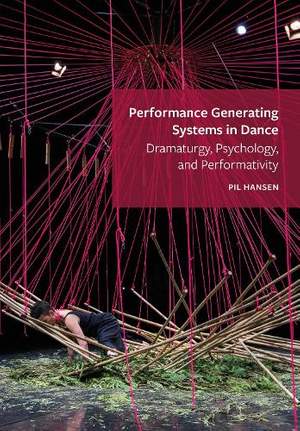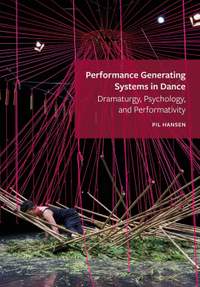
Performance Generating Systems in Dance: Dramaturgy, Psychology, and Performativity
- Author: Hansen, Pil
Book
$35.25Contents
- Acknowledgements
- List of Figures
- 1. Introduction: Performance Generating Systems in Dance
- Conceptualizing and researching performance generating systems
- Three analytical and dramaturgical frameworks in application
- - Dramaturgy
- - Psychology
- - Performativity
- PART ONE: DRAMATURGY
- 2. The Dramaturgical Agency of Performance Generating Systems
- Developments in dramaturgical agency
- Departures from choreography
- Differences from improvisation
- Concepts of memory at work
- Memory and agency in performance generating systems
- 3. Analyzing and Notating Performance Generating Dramaturgies as Dynamical Systems
- Notation challenges
- Dynamical Systems Theory
- DST-based tools of analysis and notation
- 4. Recycled Choreographic Memory in relay : Henderson
- Futuring memory
- The dynamics of futuring memory
- Ethics of affecting memory
- PART TWO: PSYCHOLOGY
- 5. The Cognitive Demands and Learning Effects of Performance Generating Systems
- The emergence of dance psychology
- Notes on methodology
- An earned presence
- - Kinaesthetic perception and perceptual integration
- - Recalling and perceiving through memory
- - Constraints and distributed, extended cognition
- - Implicit and explicit learning
- - Disrupting and manipulating implicit processes
- - Unlearning and recalibrating perception
- 6. Learning in Whole in the Head : Forsythe
- Improvisation Technologies : imaging movement modalities
- Building an ensemble: collective memory and skill development
- Opening the near closed ‘soft clock’
- - Generating components within narrow boundaries
- - Self-organizing dynamics and the attractor of emergent performer agency
- Closing the near open ‘supernova’
- - Expanded generating components and exploded boundaries
- - The self-organizing attractor of ensemble memory and agency
- Learning WitH an ensemble
- 7. Unlearning in I’ll Crane for You : Hay through House
- Testing the boundaries of performance generating systems with Hay through House
- Generating components
- - Practice
- - Adapting performer
- - Score
- - Agreement
- - Transferability
- Learning to unlearn
- PART THREE: PERFORMATIVITY
- 8. Affecting the (Im)possibility of Change: Performativity and Trauma
- Moving from dramaturgy and psychology through performativity
- Performativity: discursive
- Performativity: posthuman
- Potential of change in performance generating systems: phase transitions
- (Un)changeable conditions: trauma
- Performative Agency
- 9. Transition from Dissociation to Intimacy in Crave : Kaeja
- Craving touch: sourcing dissociation
- Creating ‘touch’
- Safety through transfer
- Phase transition towards relational, performative agency
- Process strategies
- 10. Environmental Entanglement in the Dance Machine : Lee
- Querying belonging: sourcing displacement
- A simple dance: devising a consensual feedback system
- Generating components and phase transition: listening to collective/environmental interaction
- - Transitions from hesitant/unconnected performance to engagement
- - Immersive rest and robust forms of creative engagement
- - Invited forms of collaborative engagement
- Performative strategies
- 11. Conclusion: Affecting Agency, Learning, and Change through Performance Generating Systems
- The conceptualization of performance generating systems
- Dramaturgical, psychological, and performative case insights
- The combined theoretical frameworks and their future application
- Appendix: Methodological Negotiations
- Bibliography
- Index



